Tinyakova Elena, Kursk State University, Russia
advertisement
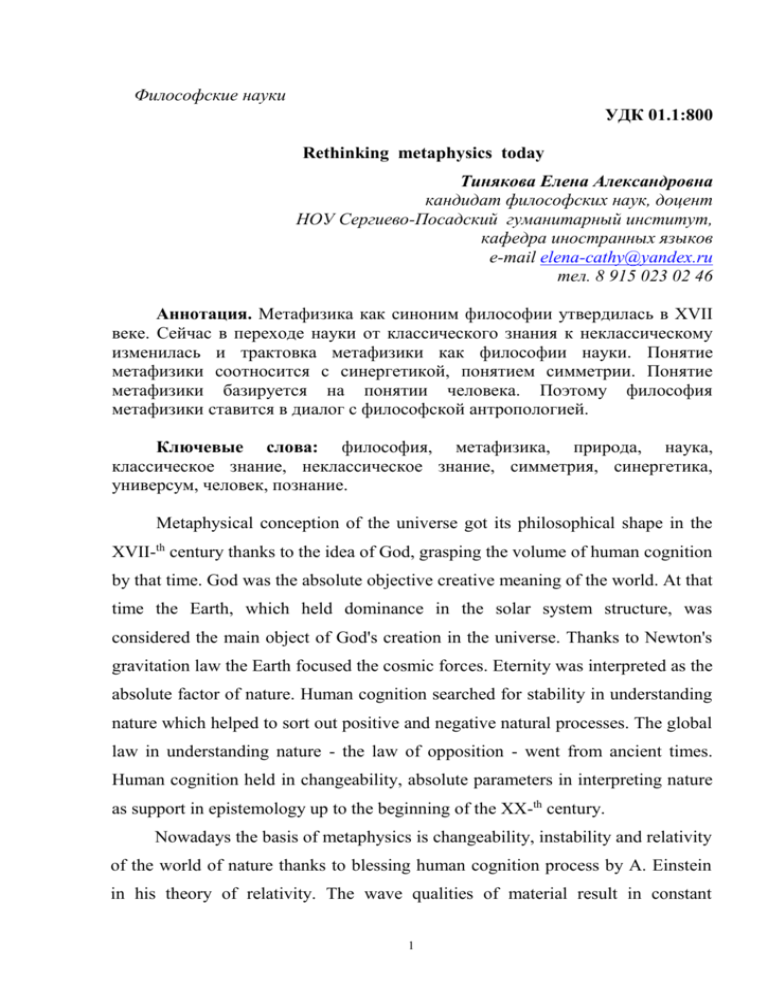
Философские науки УДК 01.1:800 Rethinking metaphysics today Тинякова Елена Александровна кандидат философских наук, доцент НОУ Сергиево-Посадский гуманитарный институт, кафедра иностранных языков e-mail elena-cathy@yandex.ru тел. 8 915 023 02 46 Аннотация. Метафизика как синоним философии утвердилась в ХVII веке. Сейчас в переходе науки от классического знания к неклассическому изменилась и трактовка метафизики как философии науки. Понятие метафизики соотносится с синергетикой, понятием симметрии. Понятие метафизики базируется на понятии человека. Поэтому философия метафизики ставится в диалог с философской антропологией. Ключевые слова: философия, метафизика, природа, наука, классическое знание, неклассическое знание, симметрия, синергетика, универсум, человек, познание. Metaphysical conception of the universe got its philosophical shape in the XVII-th century thanks to the idea of God, grasping the volume of human cognition by that time. God was the absolute objective creative meaning of the world. At that time the Earth, which held dominance in the solar system structure, was considered the main object of God's creation in the universe. Thanks to Newton's gravitation law the Earth focused the cosmic forces. Eternity was interpreted as the absolute factor of nature. Human cognition searched for stability in understanding nature which helped to sort out positive and negative natural processes. The global law in understanding nature - the law of opposition - went from ancient times. Human cognition held in changeability, absolute parameters in interpreting nature as support in epistemology up to the beginning of the XX-th century. Nowadays the basis of metaphysics is changeability, instability and relativity of the world of nature thanks to blessing human cognition process by A. Einstein in his theory of relativity. The wave qualities of material result in constant 1 dynamics of our universe and deny the opposition between substance and energy. According to quantum theory in similar experiments with similar objects we get different results. The three principles of quantum theory are: uncertainty, supplementarity, probability. The Copenhagen position in quantum theory denies "reason-consequence relation" in the world's development and postulates in determinability. Chance rules contemporary cognition process. Information space develops in the form of collecting all varieties and variabilities of our universe. This is one of the reasons of contemporary information crisis. Sometimes varieties of one process or object go very far from one another and we have then to recognize opposite positions in research. If in classic metaphysics the source of development lay in natural oppositions of our universe, in our times the stimulus for nature development lies in human knowledge itself. We build our dialogue with nature from opposite positions and hence get opposite results. Here it is just time to refer to the role of symmetry and synergetic in contemporary research and contemporary conception of metaphysics. E.Noether formulated the theoretical principle of symmetry in her theorem (1918): if any system is invariant in relation to some global transformation, then it has a certain quantity, having a preserving function. Examples of external symmetry: laws of preserving energy, impulse, moment of impulse. Examples of internal symmetry: global calibration symmetry of the electromagnetic field and as a consequence the law of preserving the electric charge. Symmetry as a philosophical category in contemporary metaphysics means the process of existing and generating identity moments in certain conditions and certain relations among various and contradictory conditions of world processes. The essential point of contemporary metaphysic is synergetic. It began getting dominance in research since the 70-ies of the XX-th century. Synergetic drives the laws of nature from the anthropological space. The methodological positions, which synergetic gives to human cognition, are the following: -destruction and creation, degradation and evolution are equal in significance; -complexity and getting in order grow further and further in 2 distance from each other; -chaos is not only destructive, but also creative; -linear development, which is realized in the reason-result chain, is rather an exception; -non-linear development predominates in evolution, that is many factors work in the form of syncretic entity; -development is guided by chance, a chance is built into the essence of evolution. Synergetic approach to contacts with nature gives a new type of experiment: the one who makes an experiment changes his role of an outward observer to a component of being experimented reality. Observation is gradually losing its authority in research. A chance in contradiction to a reason in synergetics should be understood as bringing laws of nature beyond the anthropological cognitive space. Quantum theory turns into information theory: relations among particles are realized by transporting information, specific fields being its carriers. The contemporary metaphysics explains "nothignness' in a new way: vacuum is a dynamic system having intensive fluctuations, which are the source of materia and energy. Vacuum is the energy condition of the quantum field. According to the formula by de Broile every object with the mass "m" and the velocity "v" is realized in the form of a wave. The process of annihilation between an electron and a positron gives two photons. From here proceeds the idea that light is the source of our universe. In humanitarian sciences light embodies God. This idea is the basis of religious, Christian first and foremost esthetics. Light is the beginning of our universe. In ancient times Heraclitus stated: cosmos is organism of fire. The principle of the unity of our universe has a different interpretation in contemporary metaphysics. It can be proved by the chemical law of stability of composition: one and the same chemical substance has the same quantitative composition independent from the way of its producing. This idea is supported by other basic chemical laws: the law of multiple relations, the law of volume 3 relations. The contemporary metaphysics intensifies the idea of interrelation among particles. According to Bell's theorem there are no isolated systems, every particle has moment relations with the rest of particles. The interpretation of the universe proves endless variability of the world of nature. It is better to explain how human cognition has come to this interpretation, referring to the philosophical notion of space. There are three main conceptions of space in the history of science: -space as the unchangeable carrier of materia (Newton); -space determined by the qualities of various representations of materia (Leibniz); -every object determines the geometry of space (theory of relativity by A.Einstein). We have come to the point that time and space from external categories of cognition in classic metaphysics are being transformed into internal categories of human cognition in contemporary metaphysics and are rather results of cognition than the starting points of human cognition. At last two cardinal differences between classic metaphysics and contemporary one. The reservoir of human knowledge in classic metaphysics is the Earth, in contemporary metaphysics it is the Cosmos. Due to the absolute parameters of the world classic metaphysics makes the illusion of absence of motion. In marxism-leninism metaphysics was primitively explained as absence of motion. Contemporary metaphysics is associated with high dynamics of the universe. Oppositions were the basic source of the world in classic metaphysics, they explained the development of the world. Contemporary metaphysics recognizes oppositions of another type: universe/anti-universe, particle/antiparticle (an electron and a positron are the tiniest opposition level recognized by the human cognition up till now). Modern anthropology plays a substantial role in rethinking metaphysics today. Contemporary situation in philosophical anthropology may be defined as the end of classic philosophical anthropology. Classic anthropology has been restricted to a man's bodiless. The prelude of destructing classic anthropology was existentialism with its global question of the dialogue between life and death. During the 1-st and 2-nd world wars the individuality of a man's life was wiped off. 4 The second factor of destructing classic anthropology was the creation of artificial intellect. A man tried to make a model of human thinking activity. The sign and symbolic character of human language helped to do it; technical means used signs and symbols of human language. Another approach to artificial model of thinking activity and biological structure of a man as a whole is digital processing of brain activity. The world outlook is transformed into energetic level. The dialogue of field and substance, researched by physicists, leads to dematerialization of the world of things. The biological image of a man is presented by the dialogue: reason and biofield. Primitive reason is detected even in a cluster of bacteria, today – nanobacteria. All living things of the biosphere are united together and a huge thinking space is created, which has been being produced for one milliard years. Here also belong aspirations to establish contacts with other worlds of reason in the universe. These aspirations are based on the conception of human language, but the portions of thought, sent into cosmos, surpass the anthropologic space. Classic philosophical anthropology ends and is transformed into non-classic anthropology: -human individuality is destroyed; -harmony in human space is distorted; -meaning loses its anthropological background, realized in human bodiless; -the conception of BIOS is devoid of social characteristics. The anthropological crisis of a post-modernist man is realized in broken, fragmentary conscience. Brook-Rose, an English critic, makes a pessimistic conclusion of the dissolving of a literary character. He mentions five reasons of crashing the traditional character: epistemology crisis, epistemology uncertainty, loss of popularity of the literary genres with distinct plots, growth of popularity of popular genres with elements of primitivism, influence of mass media. Life experience in the XX-th century is overwhelmed with horror and insanity. Philosophers display a keen interest to the border between logical human intellect and non-anthropological meaning, it is pathologic cases of human communication. 5 This interest makes a model of global communication in the universe and removes the breaks of it beyond human space. Now let's compare the presence of God in classic and contemporary metaphysics. In the picture of nature, dating to the XVII-th century, God was the general clock-maker (the metaphor belonging to Hobbes). He put the clock mechanism into operation and was the supervisor of its work. In contemporary metaphysics the conception of God is supported by the dialogue of religion and science. Science is gradual disclosing of nature laws, scientific information is so numerous in topics that it is impossible to perceive one focus from which it is being emanated. Today researchers and scientists say that "unknown force moves our universe". The conception of God in contemporary metaphysics stands far from concrete religious behavior. It is energy and light. The very conception of God is a scientific. 6
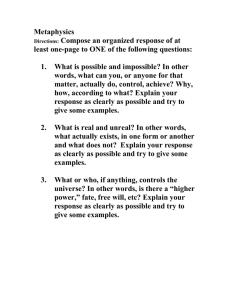
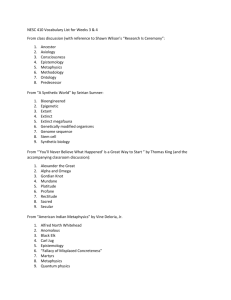
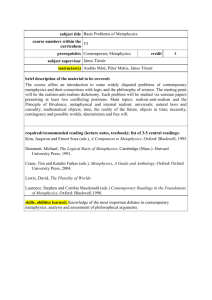
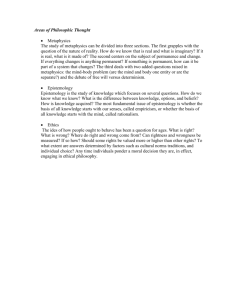
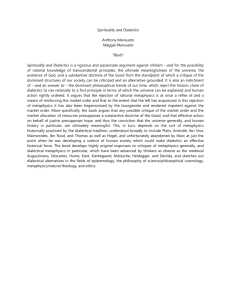
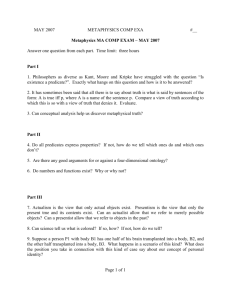
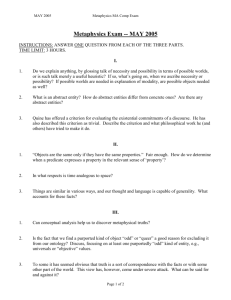
![METAPHYSICS [PH20F]](http://s3.studylib.net/store/data/007798869_2-162d842c24300a3771092030307ccdcb-300x300.png)